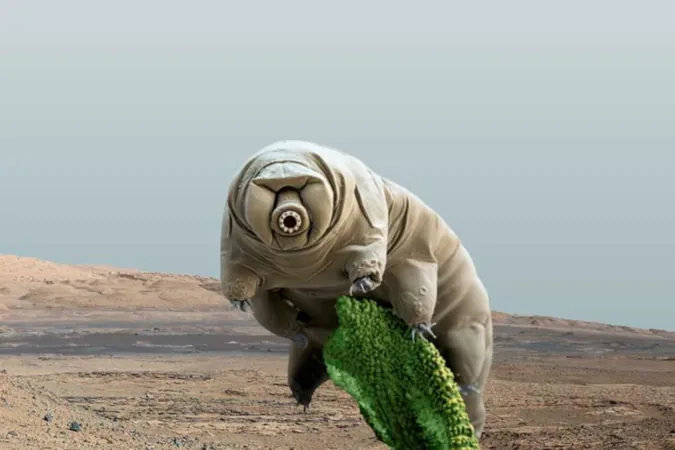
Meet the Only Earth Creatures Brave Enough to Survive Martian Conditions!
2025-09-21
Author: Mei
Mars: The Harshest Environment Known to Life
Mars is a brutal world for any living being accustomed to Earth's nurturing environment. With an average surface temperature plummeting to a frigid -63°C (-81°F), conditions rarely exceed freezing, even at the equator during summer.
Adding to the challenge, the atmospheric pressure on Mars is akin to standing at an astonishing 35 km (nearly 115,000 ft) above Earth—well beyond the range of commercial planes. This thin atmosphere is primarily composed of carbon dioxide, with only trace amounts of oxygen to breathe.
Radiation and Water: Two Major Threats
Mars is drenched in radiation—400 times higher than what we experience on Earth. And liquid water? It’s nearly non-existent, with only sporadic, super-salty trickles appearing in some areas.
Survivors from Earth: Who Can Withstand the Martian Nightmare?
Despite these extreme challenges, a handful of Earthly organisms have shown remarkable resilience. From 2008 to 2016, the European Space Agency conducted ground-breaking experiments aboard the International Space Station, exposing various organisms and seeds to simulated Martian conditions.
Tardigrades, hardy little creatures known for their resilience, fungi, and various bacteria persisted for over a year, albeit in a dormant state like spores or cysts.
The Bold and the Brave: Lichens and Algae
Some lichens and algae pushed the envelope even further, showcasing actual metabolic activity when partially shielded from radiation. On Mars, these organisms could find refuge hidden in soil or nestled within rock crevices.
Desert Moss: A Glimmer of Hope?
In a 2024 breakthrough, Chinese researchers revealed that desert moss (Syntrichia caninervis) survived simulated Mars conditions. While it was able to recover and grow normally after a week, researchers noted no evidence of metabolic activity—like oxygen production—while enduring Martian-like conditions.
Perchlorates: The Hidden Danger
Unfortunately, the challenges continue. Martian soil harbors perchlorates, toxic oxidizers known to wreak havoc on cells and cause DNA damage. Under intense ultraviolet light found on Mars, these compounds become even more reactive.
The Chinese study didn’t incorporate perchlorates in their experiments; if they had, the results could have been catastrophic for the moss.
The Tenacity of Fungi and Bacteria
Some fungi have demonstrated the ability to survive perchlorates, while certain bacteria can use them as an energy source, breaking them down into harmless byproducts. Yet, these organisms still require water and warmer temperatures to thrive.
Mars: Nature's Ultimate Sterilizer
On Earth, we use various methods to preserve our food—freezing, dehydrating, sterilizing, pickling, and sealing away from oxygen. But Mars embodies all these preservation techniques simultaneously! If we aimed to sterilize a planet, we’d struggle to do better than what Mars achieves naturally.
Could Life from Earth Really Survive on Mars?
This article stems from a question posed by a curious reader, Robin Mason from Manchester: 'Is there anything on Earth that could withstand conditions on Mars?' While some Earth organisms show the ability to survive, the complexities of Mars present an ongoing challenge for life as we know it.


 Brasil (PT)
Brasil (PT)
 Canada (EN)
Canada (EN)
 Chile (ES)
Chile (ES)
 Česko (CS)
Česko (CS)
 대한민국 (KO)
대한민국 (KO)
 España (ES)
España (ES)
 France (FR)
France (FR)
 Hong Kong (EN)
Hong Kong (EN)
 Italia (IT)
Italia (IT)
 日本 (JA)
日本 (JA)
 Magyarország (HU)
Magyarország (HU)
 Norge (NO)
Norge (NO)
 Polska (PL)
Polska (PL)
 Schweiz (DE)
Schweiz (DE)
 Singapore (EN)
Singapore (EN)
 Sverige (SV)
Sverige (SV)
 Suomi (FI)
Suomi (FI)
 Türkiye (TR)
Türkiye (TR)
 الإمارات العربية المتحدة (AR)
الإمارات العربية المتحدة (AR)